One-Dimensional Shaving-like BiVO4 Nanobelts: Synthesis, Characterization and Photocatalytic Activity with Methylene Blue
Abstract
:1. Introduction
2. Results and Discussion
2.1. Structure and Morphology
2.1.1. The FTIR Spectrum (a) and XRD Pattern (b) of the BiVO4 Sample
2.1.2. FE-SEM and TEM
2.1.3. N2 Adsorption–Desorption Isotherms and Diffuse Reflectance Spectroscopy
2.1.4. XPS Measurement
2.2. Possible Synthesis Mechanism
2.3. Photoelectrochemical Analyses
2.4. The Performance of the Photocatalysis
2.5. Possible Photocatalytic Mechanism
3. Materials and Methods
3.1. Chemicals
3.2. Preparation of One-Dimensional BiVO4 Nanobelts
3.3. Product Characterization and the Visible-Light Catalysis Experiment
3.4. Photoelectrochemical Measurement
4. Conclusions
Author Contributions
Funding
Data Availability Statement
Conflicts of Interest
References
- Duan, S.; Liu, J.; Pang, Y.; Lin, F.; Meng, X.; Tang, K.; Li, J. A generalized method for the synthesis of carbon-encapsulated fe3o4 composites and its application in water treatment. Molecules 2022, 27, 6812. [Google Scholar] [CrossRef] [PubMed]
- Xu, H.; Li, M.; Wang, J. Photocatalytic degradation of methylene blue using Nano-ZnO at air lift circulating reactor. Adv. Mater. Res. 2012, 476–478, 1910–1914. [Google Scholar] [CrossRef]
- Kudo, A.; Omori, K.; Kato, H. A novel aqueous process for preparation of crystal form-controlled and highly crystalline BiVO4 powder from layered vanadates at room temperature and its photocatalytic and photophysical properties. J. Am. Chem. Soc. 1999, 121, 11459–11467. [Google Scholar] [CrossRef]
- Long, M.C.; Cai, W.M. Photocatalytic and Photoelectrochemical Properties of p-n Heterojunction Composites. Materials Science and Technologies; Nova Science Publishers: New York, NY, USA, 2010; pp. 297–321. [Google Scholar]
- Ye, H.; Lee, J.; Jang, J.S.; Bard, A.J. Rapid screening of BiVO4-based photocatalysts by scanning electrochemical microscopy (secm) and studies of their photoelectrochemical properties. J. Phys. Chem. C 2010, 114, 13322–13328. [Google Scholar] [CrossRef]
- Zhang, H.M.; Liu, J.B.; Wang, H.; Zhang, W.X.; Yan, H. Rapid microwave-assisted synthesis of phase controlled BiVO(4) nanocrystals and research on photocatalytic properties under visible light irradiation. J. Nanopart. Res. 2008, 10, 767–774. [Google Scholar] [CrossRef]
- Channei, D.; Nakaruk, A.; Khanitchaidecha, W.; Jannoey, P.; Phanichphant, S. Hybrid high-porosity rice straw infused with BiVO4 nanoparticles for efficient 2-chlorophenol degradation. Int. J. Appl. Ceram. Tec. 2019, 16, 1060–1068. [Google Scholar] [CrossRef]
- Hernandez-Uresti, D.B.; Sanchez-Martinez, D.; Vallejo-Marquez, J.; Obregon, S.; Vazquez, A. Facile preparation of BiVO4 thin film by screen-printing technique for its photocatalytic performance in the degradation of tetracycline under simulated sunlight irradiation. Res. Chem. Intermediat. 2019, 45, 2855–2867. [Google Scholar] [CrossRef]
- Ho-Kimura, S.; Soontornchaiyakul, W.; Yamaguchi, Y.; Kudo, A. Preparation of nanoparticle porous-structured BiVO4 photoanodes by a new two-step electrochemical deposition method for water splitting. Catalysts 2021, 11, 136. [Google Scholar] [CrossRef]
- Yue, S.; Chen, L.; Zhang, M.; Liu, Z.; Chen, T.; Xie, M.; Cao, Z.; Han, W. Electrostatic field enhanced photocatalytic CO2 conversion on BiVO4 nanowires. Nano-Micro Lett. 2022, 14, 15. [Google Scholar] [CrossRef]
- Tokunaga, S.; Kato, H.; Kudo, A. Selective preparation of monoclinic and tetragonal BiVO4 with scheelite structure and their photocatalytic properties. Chem. Mater. 2001, 13, 4624–4628. [Google Scholar] [CrossRef]
- Sun, J.; Zhang, Z.; Suo, H.; Chen, Y.; Xiang, J.; Guo, C. Temperature self-monitoring photothermal nano-particles of er3+/yb3+ co-doped zircon-tetragonal BiVO4. Ceram. Int. 2021, 47, 409–415. [Google Scholar] [CrossRef]
- Lin, Y.; Chi, H.; Lin, J.; Chen, F.; Chen, C.; Lu, C. Eight crystalline phases of bismuth vanadate by controllable hydrothermal synthesis exhibiting visible-light-driven photocatalytic activity. Mol. Catal. 2021, 506, 111547. [Google Scholar] [CrossRef]
- Trinh, D.N.; Hong, S. Facile solvothermal synthesis of monoclinic-tetragonal heterostructured BiVO4 for photodegradation of rhodamine B. Catal. Commun. 2020, 136, 105920. [Google Scholar]
- Duy, T.N.; Hong, S. The effect of solvent on the synthesis of BiVO4 using solvothermal method and their photocatalytic activity under visible light irradiation. Top. Catal. 2017, 60, 782–788. [Google Scholar]
- Wei, J.; Wang, X.; Li, W.; Li, Y.; Zhu, X.; Zhu, L. Mulberry-like BiVO4 architectures: Synthesis, characterization and their application in photocatalysis. Crystengcomm 2021, 23, 4028–4037. [Google Scholar] [CrossRef]
- Packiaraj, R.; Devendran, P.; Bahadur, S.A.; Nallamuthu, N. Structural and electrochemical studies of scheelite type BiVO4 nanoparticles: Synthesis by simple hydrothermal method. J. Mater. Sci.-Mater. Electron. 2018, 29, 13265–13276. [Google Scholar] [CrossRef]
- Khan, I.; Ali, S.; Mansha, M.; Qurashi, A. Sonochemical assisted hydrothermal synthesis of pseudo-flower shaped bismuth vanadate (BiVO4) and their solar-driven water splitting application. Ultrason. Sonochem. 2017, 36, 386–392. [Google Scholar] [CrossRef]
- Yao, M.; Liu, M.; Gan, L.; Zhao, F.; Fan, X.; Zhu, D.; Xu, Z.; Hao, Z.; Chen, L. Monoclinic mesoporous BiVO4: Synthesis and visible-light-driven photocatalytic property. Colloids Surf. A 2013, 433, 132–138. [Google Scholar] [CrossRef]
- Pingmuang, K.; Nattestad, A.; Kangwansupamonkon, W.; Wallace, G.G.; Phanichphant, S.; Chen, J. Phase-controlled microwave synthesis of pure monoclinic BiVO4 nanoparticles for photocatalytic dye degradation. Appl. Mater. Today 2015, 1, 67–73. [Google Scholar] [CrossRef]
- Hosogi, Y.; Kato, H.; Kudo, A. Synthesis of SnNb2O6 nanoplates and their photocatalytic properties. Chem. Lett. 2006, 35, 578–579. [Google Scholar] [CrossRef]
- Liu, Y.; Wu, Q.; Zhao, Y. Biomimetic synthesis of Ag3PO4-nps/cu-nws with visible-light-enhanced photocatalytic activity for degradation of the antibiotic ciprofloxacin. Dalton Trans. 2017, 46, 6425–6432. [Google Scholar] [CrossRef]
- Pu, Y.; Wang, J.; Huang, Y.; Chen, C.; Kim, S.I.; Seo, H.J. Visible-light-induced degradation of methylene blue by SrBi3VO8 nanoparticles. J. Am. Ceram. Soc. 2015, 98, 2528–2533. [Google Scholar] [CrossRef]
- Zan, G.; Wu, T.; Chen, H.; Dong, F.; Wu, Q. BiVO4 nanocoral superstructures and their excellent electrical/optical dual-functions. J. Alloys Compd. 2021, 852, 157035. [Google Scholar] [CrossRef]
- Zhou, X.F.; Chen, S.Y.; Zhang, D.Y.; Guo, X.F.; Ding, W.P.; Chen, Y. Microsphere organization of nanorods directed by peg linear polymer. Langmuir 2006, 22, 1383–1387. [Google Scholar] [CrossRef]
- Zhou, X.; Zhang, D.; Zhu, Y.; Shen, Y.; Guo, X.; Ding, W.; Chen, Y. Mechanistic investigations of peg-directed assembly of one-dimensional ZnO nanostructures. J. Phys. Chem. B 2006, 110, 25734–25739. [Google Scholar] [CrossRef]
- Yu, J.; Ma, T.; Liu, S. Enhanced photocatalytic activity of mesoporous TiO2 aggregates by embedding carbon nanotubes as electron-transfer channel. Phys. Chem. Chem. Phys. 2011, 13, 3491–3501. [Google Scholar] [CrossRef]
- Wang, Y.; Tan, G.; Liu, T.; Su, Y.; Ren, H.; Zhang, X.; Xia, A.; Lv, L.; Liu, Y. Photocatalytic properties of the g-c3n4/{010} facets BiVO4 interface z-scheme photocatalysts induced by BiVO4 surface heterojunction. Appl. Catal. B-Environ. 2018, 234, 37–49. [Google Scholar] [CrossRef]
- Klahr, B.; Gimenez, S.; Fabregat-Santiago, F.; Hamann, T.; Bisquert, J. Water oxidation at hematite photoelectrodes: The role of surface states. J. Am. Chem. Soc. 2012, 134, 4294–4302. [Google Scholar] [CrossRef]
- Bhat, S.S.M.; Jang, H.W. Recent advances in bismuth-based nanomaterials for photoelectrochemical water splitting. ChemSusChem 2017, 10, 3001–3018. [Google Scholar] [CrossRef]
- Duan, F.; Zhang, Q.; Wei, Q.; Shi, D.; Chen, M. Control of photocatalytic property of bismuth-based semiconductor photocatalysts. Prog. Chem. 2014, 26, 30–40. [Google Scholar]
- Lin, Y.; Lu, C.; Wei, C. Microstructure and photocatalytic performance of BiVO4 prepared by hydrothermal method. J. Alloys Compd. 2019, 781, 56–63. [Google Scholar] [CrossRef]
- Duy, T.N.; Hong, S. Synthesis of needle-like BiVO4 with improved photocatalytic activity under visible light irradiation. J. Nanosci. Nanotechnol. 2019, 19, 7696–7701. [Google Scholar]
- Shang, M.; Wang, W.; Sun, S.; Ren, J.; Zhou, L.; Zhang, L. Efficient visible light-induced photocatalytic degradation of contaminant by spindle-like pani/BiVO4. J. Phys. Chem. C 2009, 113, 20228–20233. [Google Scholar] [CrossRef]
- Trinh, D.N.; Van-Huy, N.; Nanda, S.; Vo, D.N.; Vinh, H.N.; Thuan, V.T.; Linh, X.N.; Thuong, T.N.; Long-Giang, B.; Abdullah, B.; et al. BiVO4 photocatalysis design and applications to oxygen production and degradation of organic compounds: A review. Environ. Chem. Lett. 2020, 18, 1779–1801. [Google Scholar]
- Chatterjee, D.; Dasgupta, S. Visible light induced photocatalytic degradation of organic pollutants. J. Photoch. Photobio. C 2005, 6, 186–205. [Google Scholar] [CrossRef]
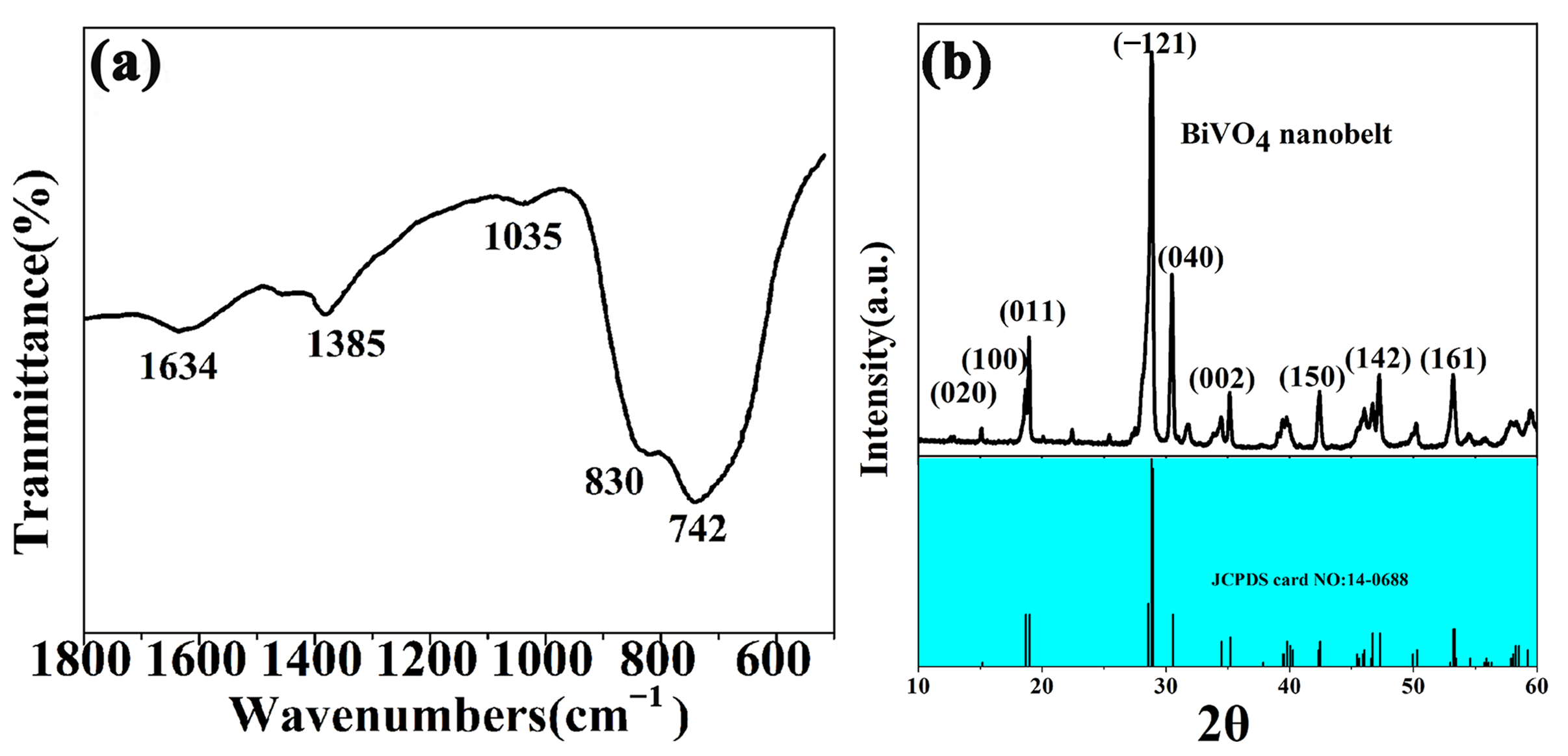
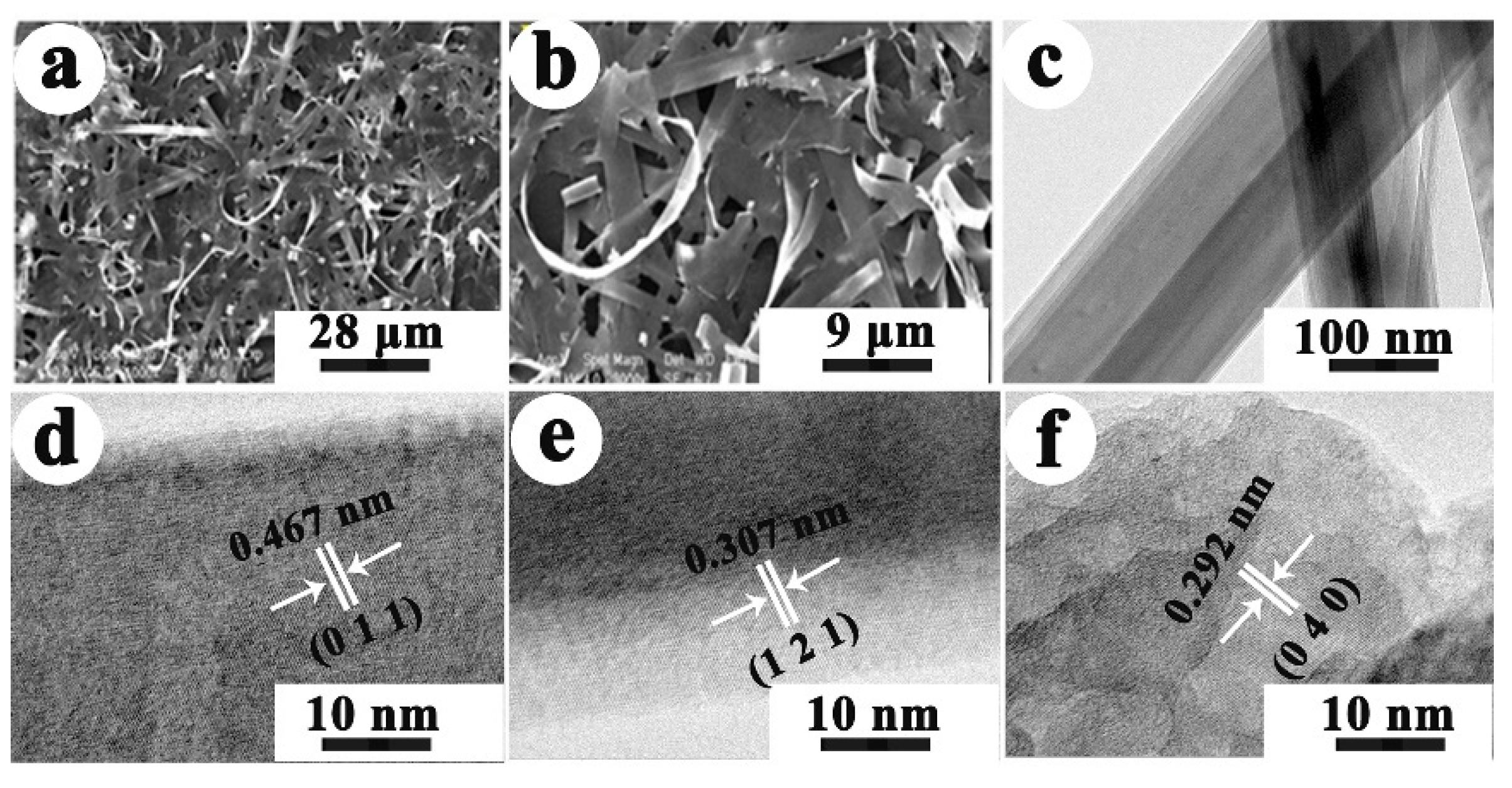

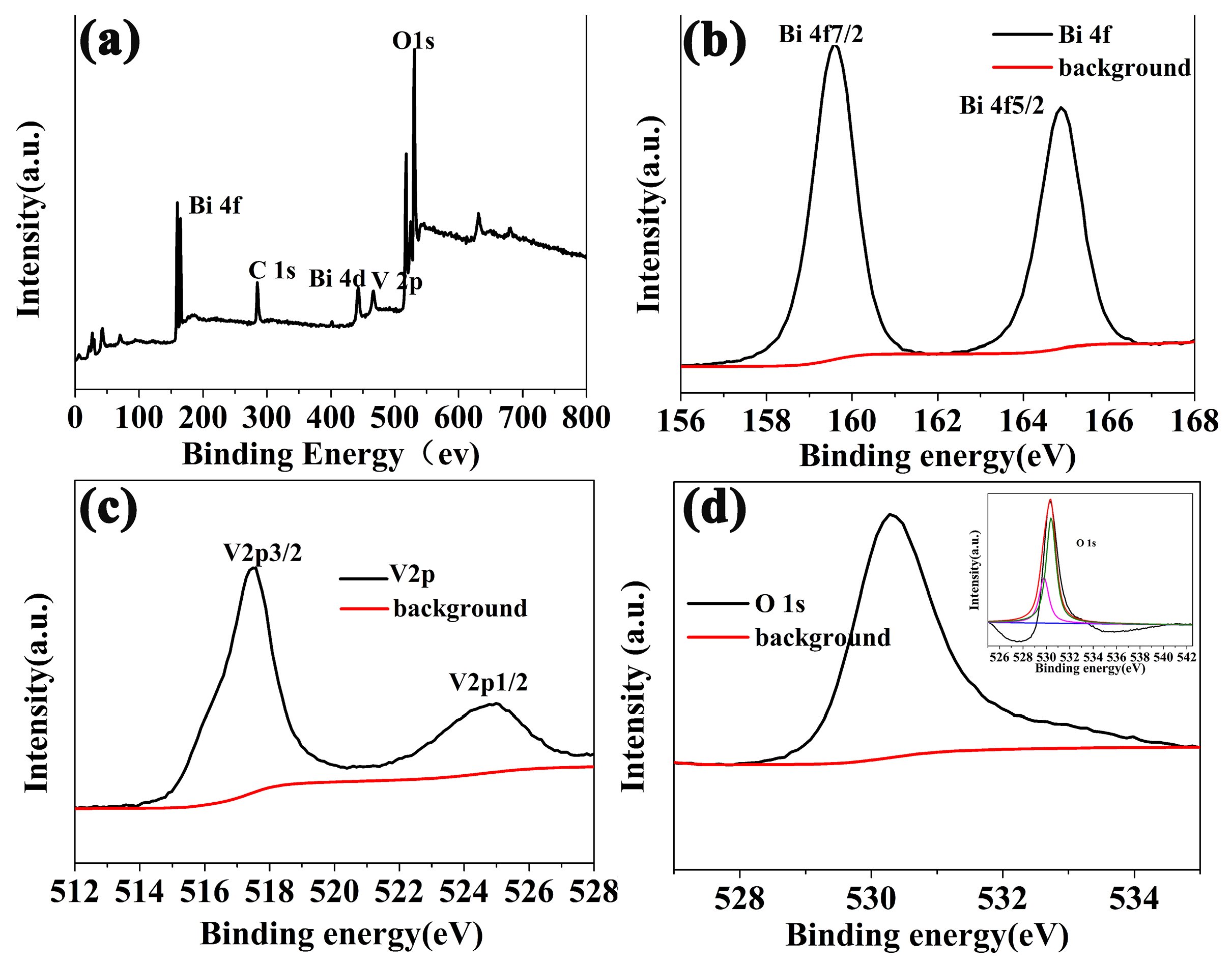
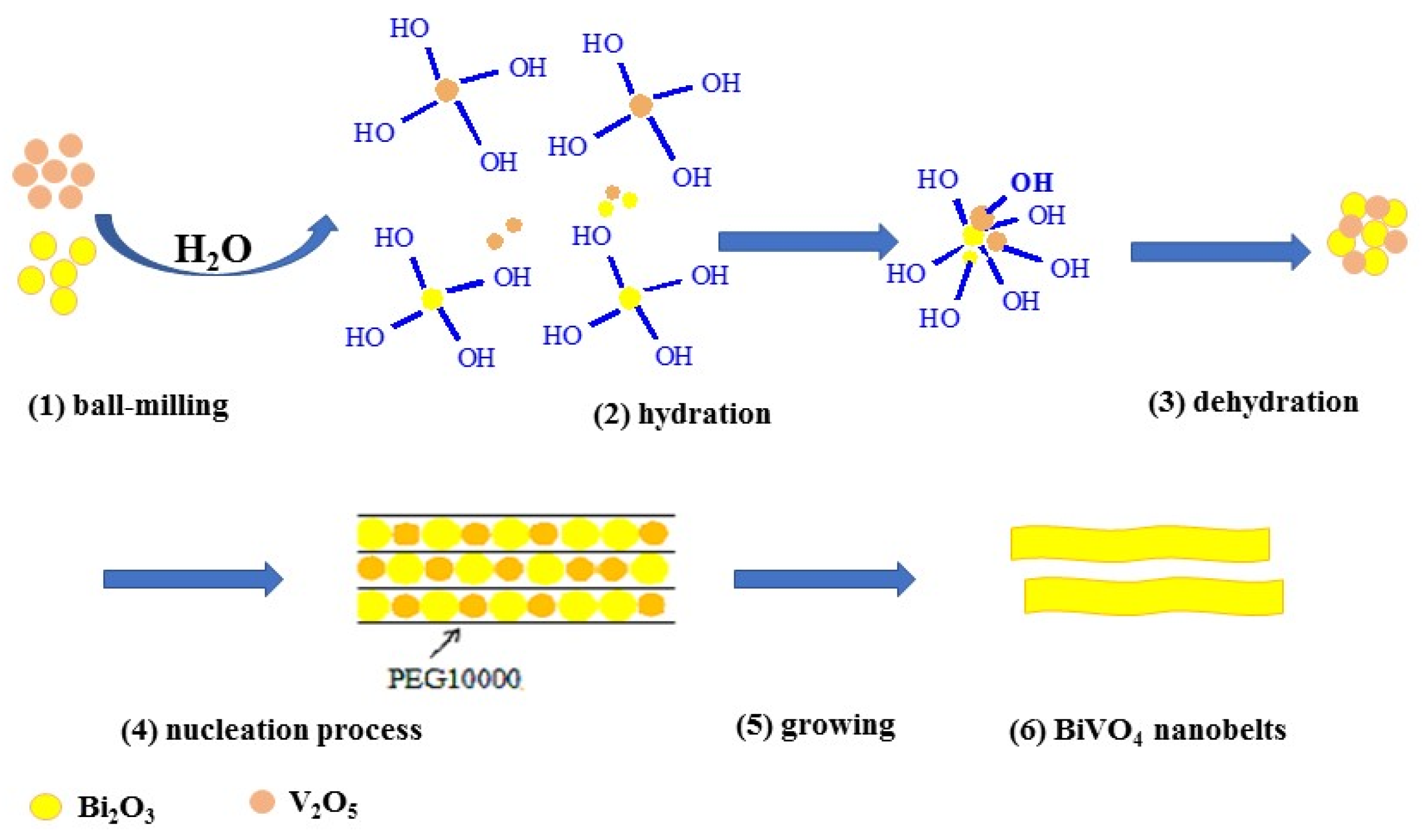


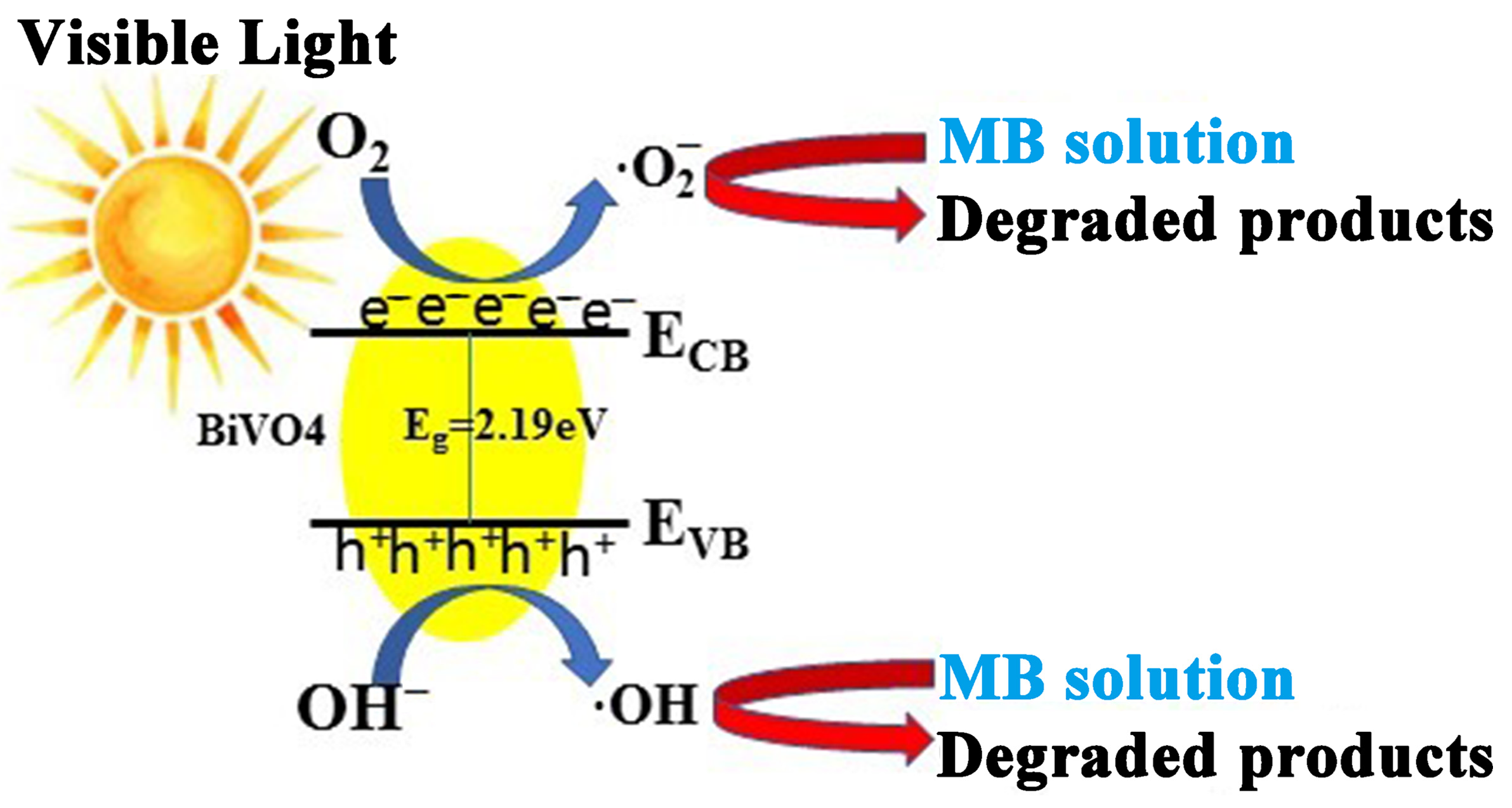
Disclaimer/Publisher’s Note: The statements, opinions and data contained in all publications are solely those of the individual author(s) and contributor(s) and not of MDPI and/or the editor(s). MDPI and/or the editor(s) disclaim responsibility for any injury to people or property resulting from any ideas, methods, instructions or products referred to in the content. |
© 2023 by the authors. Licensee MDPI, Basel, Switzerland. This article is an open access article distributed under the terms and conditions of the Creative Commons Attribution (CC BY) license (https://creativecommons.org/licenses/by/4.0/).
Share and Cite
Liu, Y.; Duan, S.; Liu, J.; Jin, X.; Dong, F.; Shi, G.; Wu, Q. One-Dimensional Shaving-like BiVO4 Nanobelts: Synthesis, Characterization and Photocatalytic Activity with Methylene Blue. Molecules 2023, 28, 7793. https://doi.org/10.3390/molecules28237793
Liu Y, Duan S, Liu J, Jin X, Dong F, Shi G, Wu Q. One-Dimensional Shaving-like BiVO4 Nanobelts: Synthesis, Characterization and Photocatalytic Activity with Methylene Blue. Molecules. 2023; 28(23):7793. https://doi.org/10.3390/molecules28237793
Chicago/Turabian StyleLiu, Yuling, Shengxia Duan, Jian Liu, Xiaomin Jin, Fengqiang Dong, Guangge Shi, and Qingsheng Wu. 2023. "One-Dimensional Shaving-like BiVO4 Nanobelts: Synthesis, Characterization and Photocatalytic Activity with Methylene Blue" Molecules 28, no. 23: 7793. https://doi.org/10.3390/molecules28237793
APA StyleLiu, Y., Duan, S., Liu, J., Jin, X., Dong, F., Shi, G., & Wu, Q. (2023). One-Dimensional Shaving-like BiVO4 Nanobelts: Synthesis, Characterization and Photocatalytic Activity with Methylene Blue. Molecules, 28(23), 7793. https://doi.org/10.3390/molecules28237793




